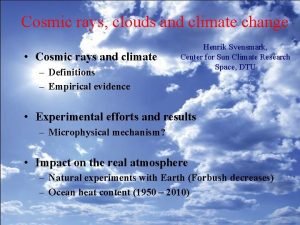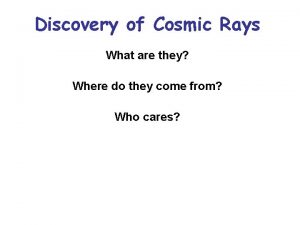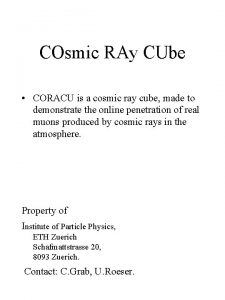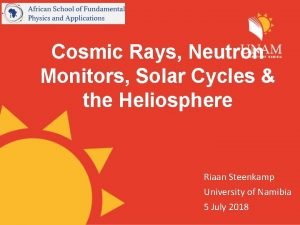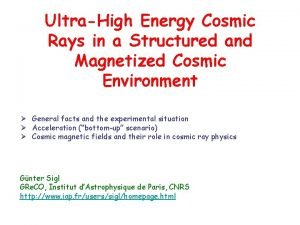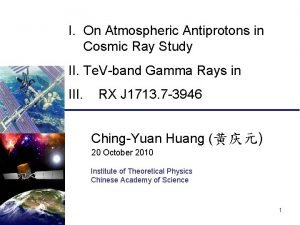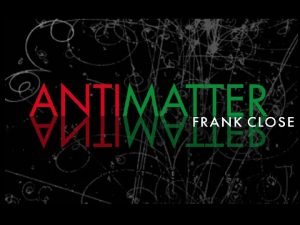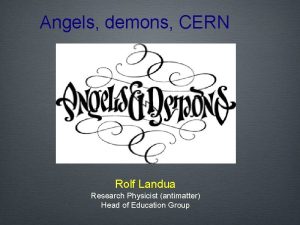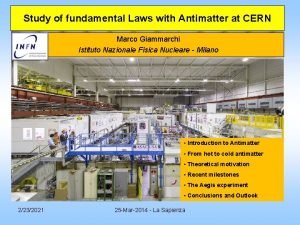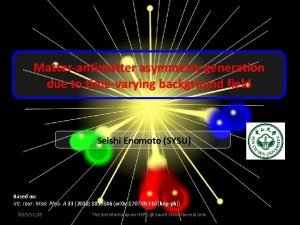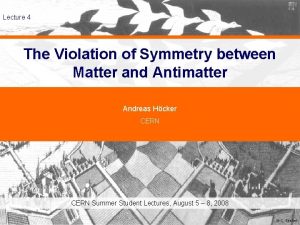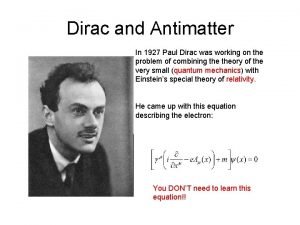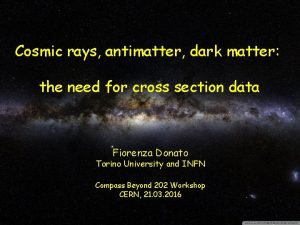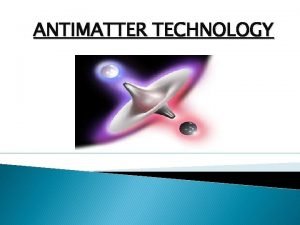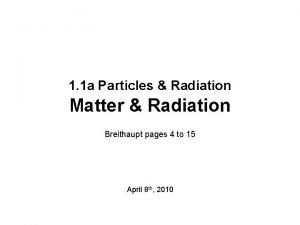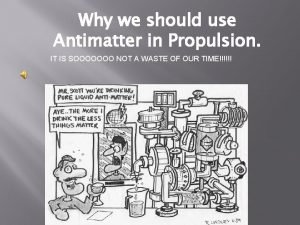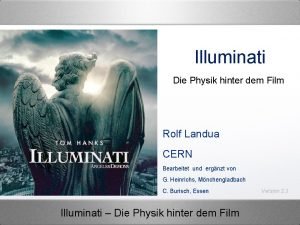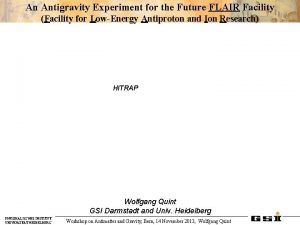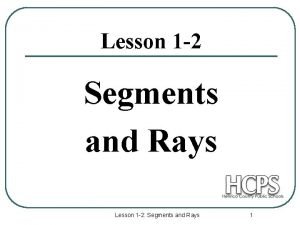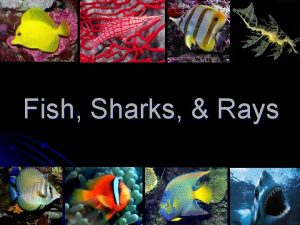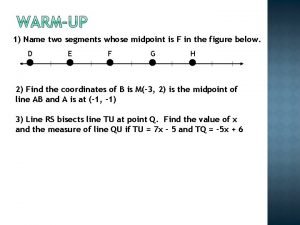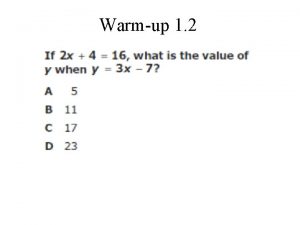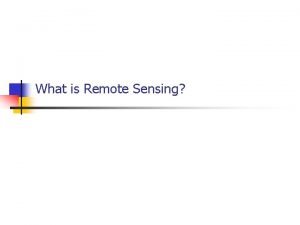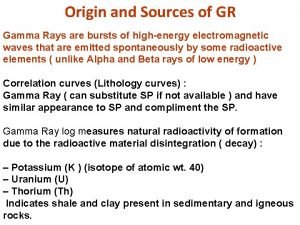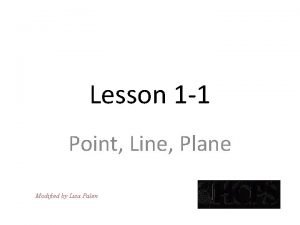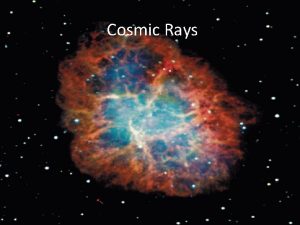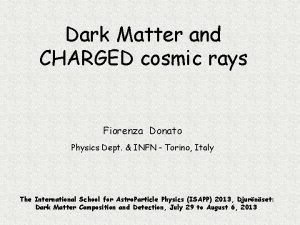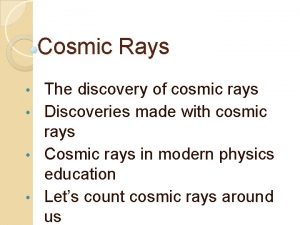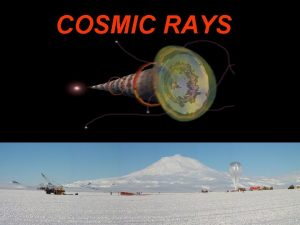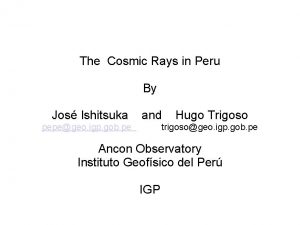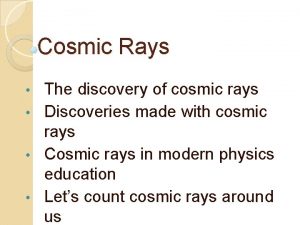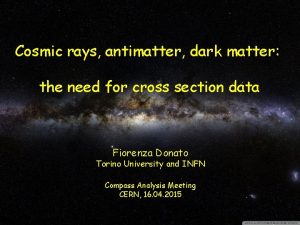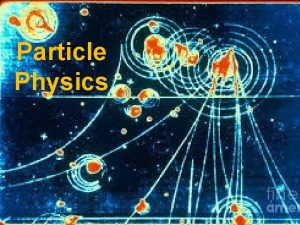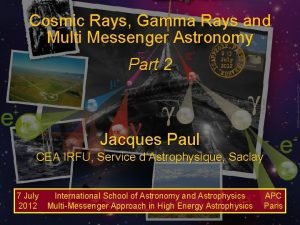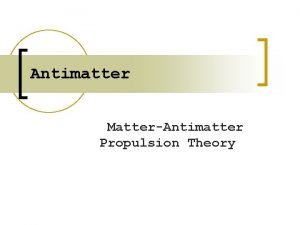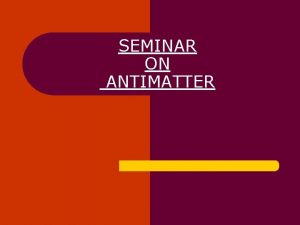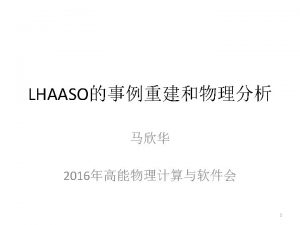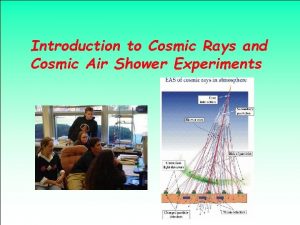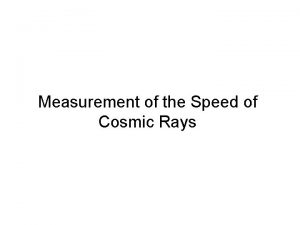Antimatter and new physics in Cosmic Rays Fiorenza
































- Slides: 32

Anti-matter and new physics in Cosmic Rays Fiorenza Donato Department of Physics , Torino University & INFN, Italy INFN WHAT NEXT on Cosmic Rays Padova, December 3, 2014

1. Positron ~580. 000 e+ identified by AMS-02, ~25. 000 by Pamela. Spectrum ~ 0. 5 -500 Ge. V AMS-02 PRL 113, 121102 (2014)

2. Antiproton ~1. 500 p+ identified by Pamela. Spectrum ~ 0. 06 -180 Ge. V Pamela, PRL 105, 121101 (2010)

3. Antideuteron 0 antideuteron measured, Bess upper limits. Detection perspectives in a near future, few Ge. V spectrum GAPS, Aaramaki et al. Astropat. Phys. 2013

4. Antihelium 0 antihelia measured, Pamela upper limits. No detection perspectives in a near future Pamela, JETP Lett. , 2011

Transport Equation (in diffusion models) Diffusion, convection Destruction on ISM CR sources: primaries, Secondaries Energy losses (EM) Reacceleration 1. Milky Way: magnetic fields, convection, interstellar gas (composition, morphology); spiral arms; diffusion zone, ……. . 2. Nuclear physics 3. Sources: nuclear spallations for secondaries; pulsars; dark matter

How far these particles come from, (if sources located in the disk)? Positrons Protons (~antip) Energetic positrons & electron are quite local due to energy losses Stable hadrons arrive at Earth from farther places; averaged

The case for positrons

Sources of positrons in the Milky Way Generically, we can list the following sources of e+ and e- in the Galaxy: 1. Secondary e+e-: spallation of cosmic p and He on the ISM (H, He) * p+H(He) p+ + p+ 0 & n+ + (mainly below 3 Ge. V) * p+H(He) p+n+ + * p+H(He) X + K 2. Primary e- and e+ from Pulsars: pair production in the strong PULSAR magnetoshpere 3. Primary e+e- from exotic sources (i. e. Dark Matter) (4. ) Primary e- from SNR: 1° type Fermi acceleration mechanism * Pamela data triggered an enormous theoretical and phenomenological activity in order to explain the positron fraction raising at high energies*

Astrophysical sources for positrons Di Mauro, FD, Fornengo, Vittino JCAP 2014 • “Known” sources (pulsars) can explain the whole positron spectrum • Propagation is important (powerful: low energies disfavor small haloes!)

Astrophysical sources & positron fraction “Known sources”: Pulsars emission is model dependent Di Mauro, FD, Fornengo, Vittino JCAP 2014 Effect of pulsar cut-off energy

Dark matter in the positron data Cirelli, Kadastik, Raidal, Strumia 2008+2013 Leptonic annihilation channels “required” only by e+ data Strongly disfavored by other indirect searches (gamma, CMB, antiprotons) Ambiguity with components from known sources (PWN)

The case for antiprotons

Antiproton in CRs: data and models Theoretical calculations compatible with CR models AMS-02 data expected Donato et al. PRL 2009 NO need for new phenomena (astrophysical / particle physics) Bounds to models (for source AND propagation) for DM in the galactic halo

Cosmic antiprotons and dark matter and ~100 uncertainty due to propagation!!!! Fornengo, Maccione, Vittino JCAP 2014 Effect of solar modulation Effect of DM radial density profile Effect of NUCLEAR CROSS SECTION UNCERTAINTY!!!

Secondary antiprotons in cosmic rays (CR) Produced by spallation reactions on the ISM p. CR + He. ISM He. CR + He. ISM +X A case for High energy particles physics: The only measured cross section is p-p +X ALL CROSS SECTIONS INVOLVING He (projectile or target) ARE DERIVED FROM OTHER DATA!!

Antiproton production: state of the art 1. p+p: σp+p antiprotons analytical expression (Tan & Ng, PRD 26 (1982) 1179; J. Phys. G: Nucl. Phys 9 (1983) 227) NA 49 data: new analysis by Di Mauro, FD, Goudelis, Serpico 1408. 0288, and Kappl & Winkler 1408. 0299 see next slides 2. 1. p+ He, He+p, He+He: σp(He)+(p, He) antiprotons derived from Monte. Carlo simulations, i. e. DTUNUC (Donato et al. Ap. J 563 (2001) 172) verified on p+C, p+Al. and heavier nuclei (Duperray et al. 2003, 2005) Data from Sugaya+1998; fit: DTUNUC Donato+ Ap. J 2001

Uncertainties on the antiproton flux from nuclear cross sections (Model from Donato et al. Ap. J 2001, PRL 2009) (includes 8% on σ pp) • pp: Tan& Ng • H-He, He-He: DTUNUC MC Maximal uncertainty from H-He: 20 -25% Functional form for the cross section derived from other reactions

Reactions involving helium & higher energies Uncertainties due to helium reactions range 40%-50%: Precise data for p-He (He-p) would reduce them significantly In the literature: - DTUNUC - Modifications of pp cross section - Other MC are viable but data on He do not exist! AMS-02 will provide data with much higher precision up to hundreds of Ge. V!!! Their interpretation risks to be seriously limited by nuclear physics

New analysis of p-p pbar data Di Mauro, FD, Goudelis, Serpico 1408. 0288; Kappl, Winkler 1408. 0299 Existing data

Antiproton source spectrum from p-p channels All data fit Different analytical functions give similar chi 2, but different extrapolation out of validity ranges uncertainties at low and high energies

Uncertainties due p-p scattering Uncertainties in the pbar production spectrum from p-p scattering are at least 10%. Conservative: 20% at low energies (Ge. V) up to 50% (Te. V) (data expected at least up to ~ 500 Ge. V)

COSMIC ANTi. DEUTERONS FD, Fornengo, Salati PRD 2001; FD, Fornengo, Maurin PRD 2001; 2008; Kadastik, Raidal, Strumia PLB 2010; Ibarra, Wild JCAP 2013; Fornengo, Maccione, Vittino JCAP 2013; …ati PRD (2000) ADD In order for fusion to take place, the two antinucleons must have low kinetic energy Kinematics of spallation reactions prevents the formation of very low antiprotons (antineutrons). At variance, dark matter annihilate almost at rest N. B: Up to now, NO ANTIDEUTERON has been detected yet.

Secondary Antideuterons Propagation uncertainties Compatibility with B/C Nuclear uncertainties Production cross sections & Pcoal Production from antiprotons Non-annihilating cross sections

Antideuterons: detection perspectives Fornengo, Maccione, Vittino 1306. 4171 3σ expected sensitivities Prospects for 3σ detection of antideuteron with GAPS (dotted lines are Pamela bounds from antiprotons)

GAPS prototype flight P. von Doetinchem et al. 1307. 3538

The case for antihelium Cirelli, Fornengo, Taoso, Vittino, JCAP 2014 (Carlson+PRD 2014) Good signal-to-background ratios Predictions for most DM models Far from experimental reach Nuclear physics brings relevant effects

A few considerations - I Existing data on antimatter do not require exotic (DM) interpretation If a DM component is present in the cosmic radiation, it will be seen at best as a very tiny spectral feature (or smeared in the background, or totally subdominant) POSITRONS are well fitted by known, powerful galactic sources. DM interpretation still open, but less natural ANTIPROTONS are can be a powerful constraining means on the DM annihilation intensity ANTIDEUTERONS are challenging, but with high detection potentials

A few considerations - II Predictions on cosmic antimatter are affected by sizeable uncertainties Uncertainties due to propagation & nuclear physics: secondary: e+ : ~ 2 -4 p-: ~ 30% D-: ~ 3 -5 DM primary: e+ : ~ 5 p-: ~ 100 D-: ~ 100 astrophysical primary e+ e- : “high” It is unavoidable to afford and reduce these uncertainties along with new antimatter experimental searches

A few considerations - III Order 0 and mandatory: Understand (==measure) cosmic proton and helium fluxes with great accuracy!!!! • PROPAGATION uncertainties need better data on MANY cosmic species and More refined models (they need to fed by many independent data on gas distribution, galactic morphology, magnetic turbulence, etc …. ) • NUCLEAR PHYSICS: we need data on cross sections: production p + He pp + He e+ p+ p, He D- (fusion!) (ancillary: p + He gamma, for Fermi-LAT data interpretation) MIGHT ONE DEDICATED COSMIC-LAB EXPERIMENT DO ALL AT ONCE? SEE TALK BY G. CAVOTO

Conclusions and perspectives Yes, it is worth to keep high interest on the antimatter A striking DM signal in antimatter seems now unexpected: we have to search tiny effects in important astrophysical contributions. Anisotropy may be a useful tool Major effort is needed in the understanding astrophysical backgrounds: a tough astrophysical work is needed A multi-wavelength and multi-channel approach - mandatory for backgrounds understanding – looks powerful for DM searches as well searches Small experiments (such as GAPS…) are - in my personal view - important and to be supported by INFN

Antiprotons: constraining tool, with caveats eff. MSSM models surviving LHC constraints and two Higgs scenarios for the scalar at 126 Ge. V (h or H) Scopel, Fornengo, Bottino 1304. 5353
 Svensmark
Svensmark Cosmic rays discoverer
Cosmic rays discoverer Cosmic rays
Cosmic rays Cosmic rays
Cosmic rays Cosmic rays
Cosmic rays Cosmic waves
Cosmic waves Angels and demons antimatter
Angels and demons antimatter Angels and demons antimatter
Angels and demons antimatter Inferno dante testo e parafrasi
Inferno dante testo e parafrasi Antimatter equation
Antimatter equation Matter antimatter asymmetry
Matter antimatter asymmetry Matter antimatter asymmetry
Matter antimatter asymmetry Antimatter equation
Antimatter equation Antimatter equation
Antimatter equation Antimatter technology
Antimatter technology Nucleus of an atom
Nucleus of an atom Antimatter
Antimatter Antimatter
Antimatter Antimatter gravity
Antimatter gravity Definition of opposite rays
Definition of opposite rays Lesson 2 segments and rays
Lesson 2 segments and rays Shark class
Shark class Another word for two
Another word for two Direct and indirect rays of the sun
Direct and indirect rays of the sun Lesson 1-3 segments rays parallel lines and planes
Lesson 1-3 segments rays parallel lines and planes Why does it happen
Why does it happen University physics with modern physics fifteenth edition
University physics with modern physics fifteenth edition Physics ia topics
Physics ia topics Limitations of remote sensing
Limitations of remote sensing Origin of gamma rays
Origin of gamma rays Name all rays
Name all rays Linear pair
Linear pair His shadow shouts on a nightmare scream
His shadow shouts on a nightmare scream
